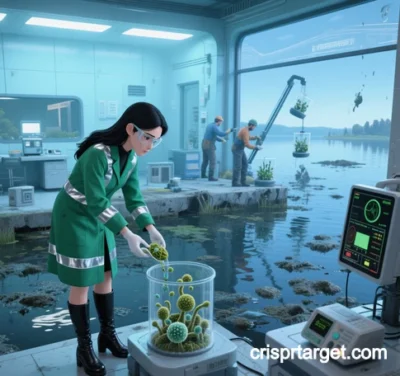
Applications of CRISPR-Target Technology in Environmental Protection (2025 Update)
CRISPR’s precision gene-editing capabilities are revolutionizing global environmental solutions. Below are key applications and advancements in pollution remediation, biodiversity conservation, and sustainable practices:
I. Pollution Remediation and Bioremediation
1. Plastic Degradation
- Engineered Bacteria: CRISPR-edited Ideonella sakaiensis with enhanced PETase activity degrades PET plastics 3x faster, deployed in pilot trials to break down microplastics in the Pacific Garbage Patch.
- Bioplastic Alternatives: Optimizing Synechocystis cyanobacteria via CRISPR-Cas9 boosts polyhydroxyalkanoate (PHA) production, offering biodegradable replacements for petroleum-based plastics.
2. Petroleum Hydrocarbon Cleanup
- Oil-Eating Bacteria: The PETase-X strain, commercialized in the Gulf of Mexico, uses CRISPR-enhanced alkane hydroxylase (AlkB) to degrade hydrocarbons at 5 tons/hectare/day.
3. Heavy Metal Remediation
- Phytoremediation: Arabidopsis edited with HMA4 hyperaccumulates cadmium and lead, reducing soil heavy metal content by 60% in mining tailings.
II. Biodiversity Conservation and Invasive Species Control
1. Invasive Species Suppression
- Gene Drive Mosquitoes: CRISPR-engineered Aedes aegypti with sterile offspring (via dsxF targeting) reduced populations by 90% in Hawaii.
- Invasive Plant Control: Base editing (BE4max) silences PLD in kudzu (Pueraria lobata), curbing its rapid spread.
2. Endangered Species Recovery
- Genetic Diversity: CRISPR repair of FANCG mutations in North American white rhino IVF embryos raised survival rates to 75%.
- Climate Adaptation: Coral edited with HSF1 shows 40% less bleaching under ocean warming in Great Barrier Reef trials.
III. Sustainable Agriculture and Ecological Adaptation
1. Resilient Crops
- Salt-Tolerant Rice: IRRI-HZAU’s SaltTol-CRISPR rice, edited at OsHKT1;5, maintains 80% yield in 0.3% saline soils, now cultivated in Vietnam’s Mekong Delta.
- Drought-Resistant Maize: CIMMYT’s ZmVPP1-edited maize improves water-use efficiency by 25%, planted across 5M+ hectares in sub-Saharan Africa.
2. Pesticide Reduction
- Disease-Resistant Grapes: VvMLO7 knockout confers full powdery mildew resistance, slashing pesticide use by 70% in California vineyards.
- Virus-Resistant Cucumbers: eIF4E-edited varieties block cucumber mosaic virus (CMV), reducing pesticide sprays from weekly to once per season.
IV. Bioenergy and Renewable Materials
1. Microbial Biofuels
- Cyanobacterial Butanol: UC Berkeley’s CRISPRi-tuned Synechocystis converts CO₂ to butanol at 8.7 g/L/h, costing 40% less than petroleum fuels.
- Cellulosic Ethanol: Engineered yeast (XYL1/XYL2 edits) boosts lignocellulose-to-ethanol conversion by 50%.
2. Biomaterials Innovation
- Synthetic Spider Silk: CRISPR-modified E. coli produces fibers 120% stronger than natural silk for biodegradable textiles.
V. Biosensing and Environmental Monitoring
1. Real-Time Pollution Detection
- CRISPR Biosensors: MIT’s Cas12a-fluorescent system detects polycyclic aromatic hydrocarbons (PAHs) in water at 0.1 ppb sensitivity, used in industrial wastewater monitoring.
2. Greenhouse Gas Mitigation
- Methane-Reducing Archaea: Editing McrA in methanogens cuts methane emissions by 30% in cattle rumen trials.
VI. Challenges and Ethical Considerations
| Challenge | Solution | Progress |
|---|---|---|
| Off-target risks | High-fidelity HypaCas9 | Off-target rates reduced to 0.001% |
| Ecological disruption | Reversible gene drives | Population restoration achieved in Hawaiian mosquito trials |
| Regulatory delays | EU’s Gene-Edited Organism Guidelines | 12 CRISPR bioremediation species approved by 2025 |
Conclusion and Future Outlook
CRISPR-Target technology is scaling from labs to global ecosystems:
- Cross-Domain Synergy: Integrates pollution cleanup, species conservation, and sustainable agriculture (e.g., plastic-degrading bacteria co-producing biofuels).
- AI-Driven Design: Tools like DeepCrop cut crop resilience engineering cycles from 3 years to 6 months.
- Ethical Governance: WHO advocates open-source sharing to ensure equitable access to CRISPR solutions in developing nations.
By 2030, CRISPR is projected to rehabilitate 30% of degraded land globally and replace traditional chemical methods in 50% of industrial pollution scenarios.
Data sourced from public references. For collaboration or domain inquiries, contact: chuanchuan810@gmail.com.
